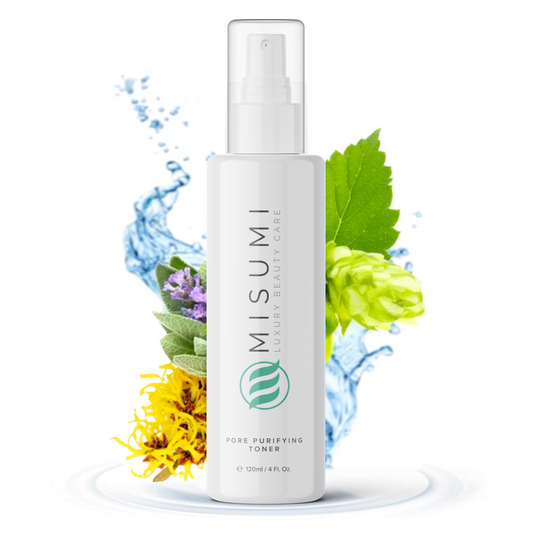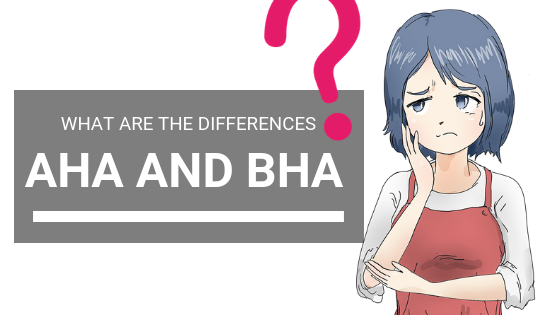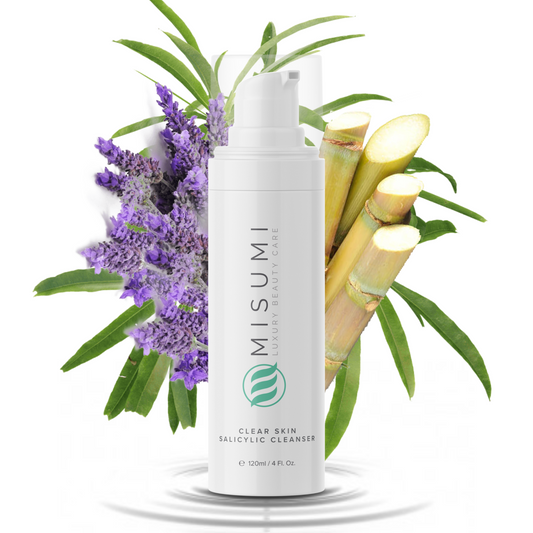Although our skin's normal pH balance is slightly acidic, not every skin loves every acid. So how do you determine what's best for your skin type?
Alpha hydroxy acids (AHAs) and Beta Hydroxy Acids (BHAs) are the superstar exfoliants in the beauty industry. They are a class of chemical compounds with a powerful ability to exfoliate the skin, slough away dead skin cells and expose a new, smoother, and more even complexion.
Both these groups are equally powerful in tackling different issues. It's up to us to learn how exactly they work on the skin, what their differences are, and how to use them most effectively for our skin type.
Liquid Exfoliants: AHAs, BHAs and Beyond

The beauty industry uses chemicals like AHAs and BHAs to create exfoliating products that guarantee a glowing complexion, fewer fine lines, and a more even skin tone. This is because the active ingredients in beta and alpha hydroxy acids have small molecules, excellent bioavailability, and can penetrate the skin to get to living cells.
In this context, the product's formulation is more important than concentration alone. The bioavailability of AHAs and BHAs is what determines their effectiveness. For example, a really concentrated AHA or BHA product with a neutral pH balance would be ineffective because the bioavailability is extremely small. But if the product has low pH, even small concentrations can be effective because a significant amount of the acid is available. The freer the acid, the more effective it can be in exfoliating your skin.
Typical scrubs are great for removing the dead skin cells on the surface of your skin. However, for them to work on more complex issues, such as wrinkles and acne, the products must be able to penetrate through the epidermis and get to the living cells in the dermis. And this is what makes beta and alpha hydroxy acids great liquid exfoliants.
There are three types of hydroxy acids used in cosmetics: AHAs, BHAs, and PHAs.

What Are AHAs?
Alpha hydroxy acids (or AHAs) are naturally occurring chemical compounds, although they can also be derived synthetically. AHAs are really well-known in the beauty industry. You can find AHAs in cleansers, toners, moisturizers, masks, and even professional peels used to reduce wrinkles, fine lines, brown spots, and discoloration. In other words, alpha hydroxy acids are used for the improvement of the overall look and feel of the skin.
The superstar in this group, with the highest bioavailability (the ability to penetrate the skin and work on deeper layers), is glycolic acid. This alpha hydroxy acid is found in sugar cane.
Lactic acid, found in sour milk, is another popular alpha hydroxy acid. It doesn't work as deeply as glycolic acid, but that's why it's much gentler and recommended for people with more sensitive skin.
Other AHAs famously used by the cosmetic industry are:
- Malic acid - This can be found in apples and is often taken as a supplement.
- Citric acid - This acid can be found in citrus fruits and has powerful antioxidant, alkalizing, and anti-inflammatory effects.
- Tartaric acid - This acid can be found in grape wine, and its derivatives have plenty of uses in pharmaceutics.

What Are BHAs?
Beta hydroxy acids, or BHAs, are organic compounds. They're close cousins of AHAs, and they're also used in the cosmetic industry. If you have oily skin or are facing frequent acne outbreaks, then BHAs might be the right choice for you. This is because they love oil and will go straight to the sebaceous glands to do their magic.
The most famous, and to be fair, the only beta hydroxy acid used in cosmetics is salicylic acid, which can be found in aspirin.
You can find it in over-the-counter products, creams, toners, masks, and of course, professional peels. BHA is more specifically advertised for acne problems because it's stronger on the skin but can also be used for wrinkles and scars.
So, is the difference between AHAs and BHAs just about their strength? Well, not quite, and we'll cover this in great detail right away.

What Are PHAs?
Before we dive in and explore the old and well-known AHAs and BHAs, we thought we'd say a few words about the new kid on the block.
Both AHA and BHA irritate those with extremely sensitive skin. This is where PHAs come into play.
Polyhydroxy acids, or PHAs, have larger molecules than AHAs and BHAs, which lessens their bioavailability and limits them to the most superficial layer of skin, the epidermis. They are great for exfoliating dead skin cells and debris, although they might not be effective against wrinkles and scars.
PHAs are so great for sensitive skin that even people with rosacea or eczema can use them. If you belong to this group, look for products containing gluconolactone and lactobionic acid.
AHAs and BHAs - What do They Have in Common?
Now that you understand hydroxy acids better, let's see how they affect the skin and how to choose the right acid for you.

Deep Exfoliation
If you're looking for good-quality skin exfoliants to give you a smoother complexion, then you can go for both AHAs and BHAs. Unless you have particularly sensitive skin, experiment with glycolic and salicylic acid to see which suits you better.
Both AHA and BHA are great agents for deep chemical exfoliation. They can remove dead skin cells and debris, clear and unclog pores, decrease the appearance of large pores, reduce superficial fine lines, even out your skin tone, and decrease inflammation. Chemical exfoliation is also much better than mechanical exfoliation and will give you radiant skin without causing harm.
Photosensitivity
You should always be extremely protective of your skin when it comes to potential sun damage, but especially when you're using hydroxy acids. These acids will make your skin photosensitive and prone to sunburns.
No matter which AHA or BHA you choose, always apply sunscreen with SPF above 30 in the morning or before going out to prevent burns, age spots, and increased skin cancer risks.

AHAs Vs. BHAs: Key Differences Explained
Bioavailability and Strength
BHAs have smaller molecules than AHAs meaning they have greater bioavailability and can penetrate the skin more effectively, reaching deeper layers and living cells. On the downside, greater bioavailability also means that the acid has a stronger effect and irritates the skin more.
To simplify things, if you want to hit hard, go for salicylic acid or glycolic acid. But sensitive skin types should go for lactic acid or even consider PHAs. Both glycolic and lactic acid will improve your overall skin texture.
Check the product's concentration and pH value before purchasing. These are the key determinants of strength and bioavailability. So, even though salicylic and glycolic acids are stronger, if the product contains them in really small concentrations and has a neutral pH value, it's most likely that the product will be gentle and less effective than a lactic acid product with a lower pH value.
If you're looking to start with salicylic acid, add our Clear Skin Salicylic Cleanser to your skincare routine.

Solubility
One of the main differences between AHAs and BHA is their water vs. oil-based solubility.
AHAs love water molecules. When these acids penetrate the skin, they lose the bonds that hold together the top layers of dead skin cells and work on the living cells of the dermis by stimulating collagen, promoting cell turnover, and battling discoloration. By promoting collagen production and cell turnover, the acids fight off wrinkles and make the skin appear tighter and younger. And by making space for new, more evenly pigmented cells, AHAs fight brown spots and discoloration.
On the other hand, beta-hydroxy acids are oil-soluble. This means BHA dissolves sebum and unclogs the pores. When salicylic acid penetrates the skin, it goes straight to the oil glands and reduces excess oil production. This is why salicylic acid is especially effective against pimples and frequent acne breakouts - it really is perfect for oily skin types.
Uses
If your main concerns are symptoms of aging (like wrinkles, brown spots, and uneven skin tone), you should go for an AHA product. If your wrinkles are deeper or your discoloration is enhanced, glycolic acid is best. But if you have sensitive skin, try lactic acid first and see how it goes. Also, AHAs and lactic acid work great for dry skin as they help lock moisture into your skin.

On the other hand, if your main problem is acne breakouts, go for BHAs, and it's one representative - salicylic acid.
Salicylic acid naturally occurs in the white willow tree and contains anti-inflammatory properties, making it great for treating blemishes and zits. This acid works its way deep into the pores and dissolves the sebum, which clears the skin and improves the condition of the pores.
Additionally, you can use AHAs and BHAs in combination with other skincare products. This is because both can boost the effectiveness of other products by allowing them to penetrate deeper into the skin.
How to Choose the Product That's Right For You

We've already covered the main determinants of what makes a product effective, and by now, you might be getting a good idea of what's right for your skin type and condition.
But, in summary, here's what you should be looking at when making a decision:
- The pH value of the product - The lower the pH value, the more acidic and stronger the product is. The effectiveness grows, but also the possibility of irritation.
- The concentration of the product - The concentration alone doesn't say much, but when you look at it in terms of pH value and concentration, this will also tell you how strong, effective, and potentially irritable a product is.
- The acid group - For dry skin, wrinkles, fine lines, discoloration, and other common skin problems, go for AHAs. For oily and acne-prone skin, BHA is the better option.
- The acid - Depending on how sensitive your skin is, you can choose acids with lesser bioavailability, which are more gentle on the skin. Use more glycolic or salicylic acid if your condition is more severe.
Should You Use AHAs And BHAs Together?

The thing is, AHAs and BHA have separate benefits. AHAs are more about clearing out dead skin cells and cell turnover, while BHAs are more about pore cleaning and inflammation reduction. This means you won't have a problem using both and maximizing the chances of a successful result.
How to Introduce Your Skin to Acids

Start With a Gentle Acid
If it's your first time using hydroxy acids for the skin, choose a product that contains a gentle acid. The safest way to start is with PHAs, but if you want something stronger and more effective, try lactic acid.
Do a Patch Test
Apply a tiny amount of the product to a small area of your neck fist, and wait 24 hours to see how your skin will react. If everything looks good and you don't develop an allergic reaction, redness, rash, or itchiness, you are good to go.
Start Slow - Once a Week
Applying once a week will give your skin time to adjust to the new pH balance and the changes the product will trigger.
Moisturize and Protect the Skin After
Exfoliating acids will do their job, but in the process, they will leave your skin sensitive and vulnerable to external pollutants and sun damage. This is why nourishing your skin with hydrating and moisturizing products is important. Don't forget to use sunscreen regularly.

How Often Should You Use AHAs and BHAs?
There are no rules, but these suggestions can safely guide you to effectively use hydroxy acids for your everyday skin concerns.
We've just mentioned that you should start applying once a week and leave some time for the skin to adjust to the changes. After a couple of weeks, or maybe a month or two, you can start using the product three to four times a week.
If you find this frequency comfortable for the skin, increase it to almost every day. Make sure your skin is reacting well to the increases in your application.
Conclusion

Hydroxy acids are powerful liquid exfoliants, offering many advantages over typical physical exfoliants. While other scrubs can scatter away dead skin cells, AHAs and BHAs can penetrate the epidermis and work their magic on the living cells inside the dermis.
The beauty industry uses three types of hydroxy acids: AHAs, BHAs, and PHAs. AHAs are best for diminishing the look of lines and wrinkles, evening out the skin tone, and improving the overall appearance of the skin.
BHAs are best for oily skin and frequent acne breakouts. PHAs are relatively new and not as famous, but they're a good alternative for people with extremely sensitive skin.
Both AHAs and BHAs share some benefits, and both make the skin sensitive to sun exposure. But, the key differences between these powerful exfoliating acids are their bioavailability, strength, solubility, and use. So, to choose the best product for your skin type, you should consider the pH value, the concentration, the acid group, and the specific acid used in the product formulation.
Make sure you start slowly before gradually increasing the use of hydroxy acid products.
With time, results will come.
References
Dual Effects of Alpha-Hydroxy Acids on the Skin
Hydroxy Acids, the Most Widely Used Anti-aging Agents
Applications of hydroxy acids: classification, mechanisms, and photoactivity










